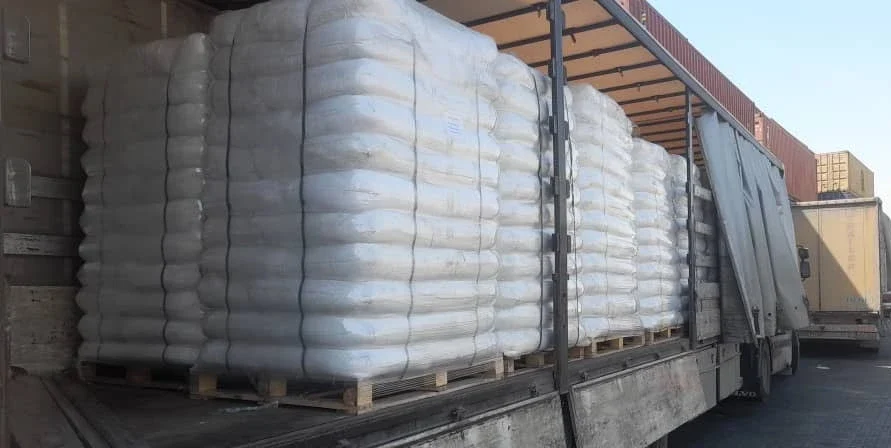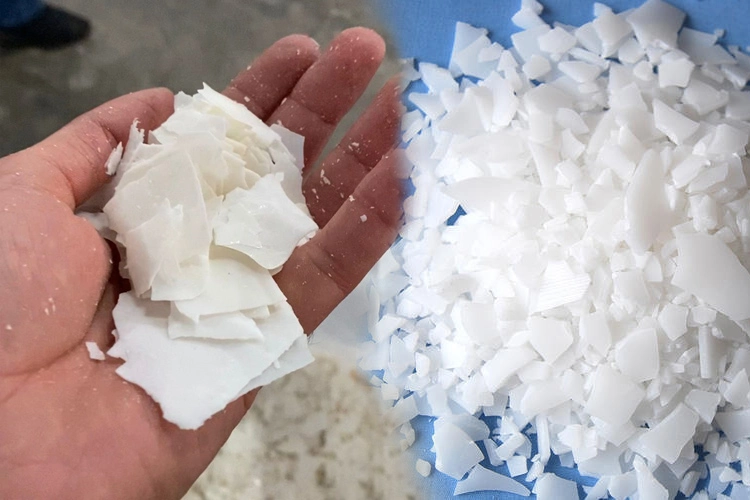What is Polyethylene Wax?
Flake PE Wax is a chemical compound produced from polyethylene polymer. Polyethylene itself is a polymer resulting from the polymerization of ethylene, which is one of the most important and common plastics in the industry. By addressing the dispersion and molecular structure of polyethylene, polyethylene wax can be understood. Polyethylene wax, as a wax compound, has properties similar to natural wax, but because it is derived from polyethylene, it has unique characteristics and properties. This wax has a longer structure in terms of the length of the polymer chains, which improves its properties. Polyethylene wax is used in various industries due to its special physical and chemical properties. This wax is mainly used as an anti-adhesion agent, anti-scratch agent, surface property improver, and additive agent in industrial processes. It is also used as a protective agent and an enhancer of product properties due to its resistance to heat, water, humidity and pressure. Overall, polyethylene wax is used as a highly functional material in various industries, including the plastics industry, paints and dyes, printing and packaging, car and flooring care, soap and hygiene products, and candle making industries, due to its unique properties.
Flake Pe Wax Are Known for:
- High melting point.
- Low viscosity.
- Chemical resistance.
- Excellent lubricity.
- Thermal stability.
These properties make them ideal for improving the performance and processing of various products.
Polyethylene Wax Flake Form Applications
Flake Pe Wax Are Commonly Used in:
Plastics: enhances mold release and improves surface finish.
Coatings: provides scratch resistance and gloss control.
Adhesives: improves melt viscosity and bonding strength.
Inks: enhances slip and rub resistance.
Cosmetics: it can be found in cosmetic and personal care products, such as lipsticks and lotions, to provide a smooth texture and glossy finish.
Candles: it can be used in candle making to improve burn time and reduce dripping.
Types of Polyethylene Wax
Polyethylene wax can be either low-density polyethylene (LDPE) or high-density polyethylene (HDPE). In general, HDPE is denser and more crystalline, so if you have a way to determine these characteristics, you can tell the two apart. However, you can use various methods to identify polyethylene wax from other materials, such as sight, touch, and smell.
- Flake PE Wax
- Powder PE Wax
- Pastile PE Wax
- Polyethylene PE 100
- Granulated HDPE BL3
Trade Names (Polyethylene Wax)
- Ceralene
- Licocene
- Licowax
- Viscowax
Properties & Characteristics of Pe Wax
Polyethylene wax is obtained from ethylene through a process called polymerization. Manufacturers vary the polymerization process to obtain a product with the desired quality. However, some basic properties of the material are common to all polyethylene waxes. As a fully saturated homopolymer of ethylene, polyethylene wax is linear and crystalline. This is why this material finds applications such as blends, plastic additives and rubber manufacturing. Due to its highly crystalline nature, this material has unique properties such as high temperature hardness and low solubility in a wide range of solvents. This material is a thermoplastic, so you can guess how it behaves when exposed to heat. Thermoplastics melt at 110 degrees Celsius. One interesting feature of these materials is the ability to be heated and cooled without much degradation. Polyethylene wax also has a limited polyol and molecular weight inequality. As a result, the material is highly resistant to chemical attack, has excellent thermal stability and is very flexible in formulating applications. Polyethylene waxes are clear, relatively hard, crystalline waxes synthesized from ethylene or polyethylene. In the non-polar form they are produced by a low-pressure process with Ziegler-Natta catalysts and in the polar form by melt oxidation. Polyethylene waxes are used in particular to regulate viscosity, melting point and hardness. The molecular weight (Mn) of polyethylene waxes can range from approximately 300 to 10,000 with melting points starting at 90 °C and extending up to 140 °C. The melt viscosity can also vary greatly, from very low (<40 mPa.s) to very high (around 90,000 mPa.s). Oxidized waxes have acid numbers starting from 14 and going up to 30 and generally have slightly lower melting points and melt viscosities due to the partial breakdown of the polyethylene backbone during the oxidation process. Unoxidized polyethylene waxes are water-white in color, where oxidized polyethylene waxes can be slightly off-white to light yellow.
Here is a Summary of the Properties of Polyethylene Waxes:
- High softening point
- High melting point
- Excellent thermal stability
- High chemical resistance
- High compatibility with wax types
- Excellent lubricity
What Are the Uses of Polyethylene Wax in Industry?
TER Chemicals polyethylene waxes are used in a variety of applications as fining agents, modifiers, carriers, release agents and lubricants. These include printing inks, adhesives, sealants, rubber, plastics, textiles, leather, paper, cosmetics, industrial cleaners, metal processing and road construction.
How is Polyethylene Wax Made?
Polyethylene wax is manufactured through diverse methods. One approach entails the direct polymerization of ethylene under specific conditions that meticulously regulate molecular weight. Alternatively, the process involves the degradation of high molecular weight polyethylene into lower molecular weight fractions. A third method comprises the isolation of the low molecular weight fraction from the high molecular weight polymer.
Differences Between Polyethylene Waxs Type
Polyethylene waxes exhibit distinctions based on three key features. These include I) molecular weight, II) degree and length of polymer branching, and III) monomer/polymer composition. Any modification in these factors results in a shift in the physical attributes of the polyethylene wax, including viscosity, hardness, melt point, reactivity, and more.
Differences Between Pe Wax and Paraffin Wax
Paraffin wax typically emerges as a by-product during oil refining, distinguished by a molecular weight generally less than half of most polyethylene waxes. This variance, among others, contributes to paraffin wax exhibiting a considerably lower melting point and softer consistency compared to the majority of PE-Wax.
Polyethylene Wax Flake Form Specification
Melting Point: 95-115°C
Viscosity: 10-200 cP at 140°C
Density: 0.92-0.94 g/cm³
Volatile: 0.1 – 4 %
Molecular Weight: 1000-3000 g/mol
According to the application of PE wax flake form, RAHA Group provide several grades such as 1919, 1200, 1925, 1937, 1370, 1380 and so on to support the customers in different applications such as piping, masterbatch, plastics and … Each grade has its own special technical specification.
Pe Wax Flake Form Handling, Storage, Safety and Packing
 Polyethylene (PE) wax flakes
Polyethylene (PE) wax flakes
Store PE wax flakes form in a cool, dry place away from direct sunlight and moisture. Use appropriate personal protective equipment (PPE) when handling the product to avoid inhalation or contact with skin and eyes. In RAHA group company, we are able to arrange different packing such as 20 KG bag, 25 KG Bag and 1250 KG Jumbo Bags. Palletizing and shrinkage will apply to avoid any damage or wet. Polyethylene wax flakes form are generally considered safe but should be handled with care. Refer to the Safety Data Sheet (SDS) for detailed information on health hazards and first aid measures. PE wax flakes are a reliable and efficient additive in various industrial applications, offering numerous benefits in terms of performance and processing.
Technical Data Sheet of Polyethylene Wax
Grade: HD Polyethylene Wax Flake 1200F (SUPER DRY)
Typical Property UNIT Value Test Method
Appearance Flake Snow White, Black Spots Free, Good Hardness, Low Volatility VRM-WI-079-00
Softening Point C 105-110 ASTM – ED3418
Penetration Index d.mm 3-4 ASTM D1321
Viscosity Cps @140C 20-40 ASTM – D3236
Density Gr/Cm3 @25C 0.9 ± 0.03 ASTM – D1505
Flash Point C 180< ASTM – D93
Technical Data Sheet of Polyethylene Wax
Grade: Polyethylene Wax Flake 1370 (Semi Dry)
Typical Property UNIT Value Test Method
Appearance Flake Snow White, Black Spots Free VRM-WI-079-00
Softening Point C 85-90 ASTM – ED3418
Penetration Index d.mm 20-30 ASTM D1321
Viscosity Cps @140C 10-40 ASTM – D3236
Density Gr/Cm3 @25C 0.9 ± 0.03 ASTM – D1505
Flash Point C 130< ASTM – D93
Supplier of Polyethylene Wax
We are a supplier of Flake PE Wax. With years of experience in the industry, we have built a reputation for delivering high-quality products to our clients across Turkey, Romania, Bulgaria, Serbia, Ukraine, Bosnia, Poland, Greece, Oman, Iraq, Pakistan, India, Taiwan, Thailand, and Vietnam. However, our team will assist at every step to ensure a smooth and timely supply. (Contact Us)


